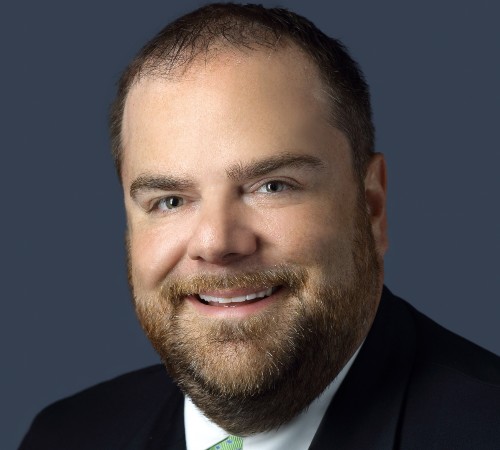The Maryland-based health system's vice president and chief innovation officer says healthcare must create platforms that connect patients to the resources they want and need.
To William Sheahan, the future of healthcare lies in connected care.
That's not exactly a new idea, says the vice president and chief innovation officer of MedStar Health, a 10-hospital, 300-plus-site health system centered in the Baltimore-Washington D.C. area, and executive director of the MedStar Institute for Innovation. But it is rooted in change management and focused on the redesign of traditional healthcare practices.
And that's a lot to swallow for an industry that hasn't quite caught on to consumer-based care.
"We have a lot to learn from other industries," he says. "I think we need to do a lot more to … improve the patient experience."

William Sheahan, vice president and chief innovation officer at MedStar Health and executive director of the MedStar Institute for Innovation. Photo courtesy MedStar Health.
For connected care to work, Sheahan says, healthcare organizations need to understand where and why those connections are necessary. Healthcare is moving away from the idea of having the patient go to the care provider and toward "the distribution of expertise using technology," whereby the provider connects with the patient, either in person or through virtual channels.
"We need to meet patients where they are," he says.
Sheahan, whose career includes time spent as a paramedic, educator, and chief officer of an emergency services organization, joined MedStar Health in 2013 as executive director of the MedStar Health Simulation Training & Education Lab (SiTEL), then took over the MedStar Telehealth Innovation Center in 2017, just in time to guide that group's exponential growth during the pandemic.
He's part of a wave of innovation and transformation leaders at healthcare organizations across the country who are taking lessons learned from the COVID-19 crisis to advocate for systemic change in a struggling industry.
"We have to look at each service line … [and] deconstruct and reconstruct it with digital care" as one of the core components, he says.
That's because consumers are demanding more convenient access to care, he says, through channels that allow them to see information (including their health data) and care providers when and where they want. If a health system or hospital is reluctant to offer those services, he says, those consumers will shop around for other care providers.
And that marketplace is growing. Retail giants like Amazon and Walmart, health plans, telehealth companies with their own cadre of doctors, and others are staking a claim in the healthcare sandbox, offering convenience and lower costs.
Sheahan says MedStar Health, like all other health systems, is faced with a "transformation imperative" that goes beyond consumerism. Operating margins are razor-thin, healthcare costs are too high, and the workforce is struggling with stress and burnout and shrinking. Health systems from the top down need to be aligned to address those issues with new ideas and technologies, including drawing ideas that have worked in banking, retail, travel, and hospitality.
"Why can't we have an experience like a Marriott or a Hilton?" he asks.
That's where efforts like the MedStar Institute for Innovation come into play. Sheahan says the center helps create a culture of innovation within the health system, creating an environment for unique ideas to improve both business workflows and clinical outcomes; which are both integral to establishing a new healthcare paradigm. Novel ideas and technologies that improve business processes and reduce stress and workflow issues for staff will, in turn, improve the patient experience and boost clinical outcomes.
"There is a lot of opportunity for automation and efficiency," he says, noting the integration of AI and analytics tools at the back end and the slow-and-gradual development of generative AI.
To address workflow shortages, particularly in the nursing ranks, Sheahan says MedStar Health needs to rethink how technology is used in the hospital setting. Concepts like interactive TV sets in patient rooms, virtual nursing (also known as telesitting), and wireless sensors that drive the "hospital room of the future" not only improve patient engagement and satisfaction but help nurses and other staff improve their outcomes and outlook.
That's not to say every innovation finds a place in the healthcare setting. Health systems like MedStar Health don’t have endless amounts of money to spend on bright new ideas.
"Investments have to be well rationalized," Sheahan says. The "burden of technology on the workforce" means that new tools must prove their value before being embraced.
Sheahan says MedStar Health can be a national leader in connected care, and points to an ongoing collaboration with Intermountain Health and Stanford Medicine as evidence. The three health systems, supported by the Agency for Healthcare Research and Quality (AHRQ), have formed the Connected CARE (Care Access, Research, Equity) & Safety Consortium to dig deeper into how healthcare organizations can use technology to connect patient and providers.
"There's a focus on building technology with our partners that will really drive this transformation," he says.
And that, he says, is how healthcare can and should evolve.
“We have to look at each service line … [and] deconstruct and reconstruct it with digital care [as one of the core components].”
— William Sheahan, vice president and chief innovation officer, MedStar Health, and executive director, MedStar Institute for Innovation.
Eric Wicklund is the associate content manager and senior editor for Innovation at HealthLeaders.
KEY TAKEAWAYS
As vice president and chief innovation officer at MedStar Health and executive director of the MedStar Institute for Innovation, William Sheahan is part of a new wave of innovation executives taking lessons learned from the pandemic to propel healthcare forward.
Sheahan says health systems need to redesign their care pathways to make digital health an integral part of care, rather than an add-on.
An ongoing collaboration with Intermountain Healthcare and Stanford Medicine, he says, is putting MedStar Health at the forefront of the connected care movement.
